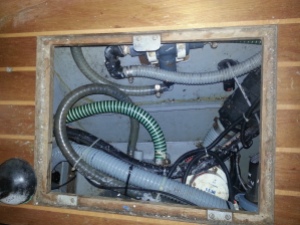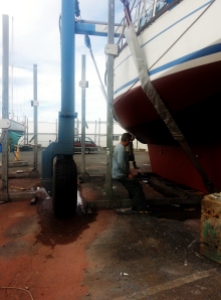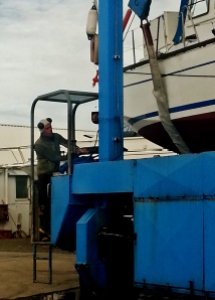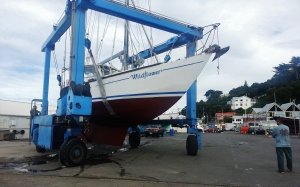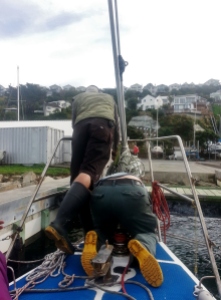I’ve just finished reading An Astronaut’s Guide to Life on Earth – Colonel Chris Hadfield’s autobiography.
For those of you who don’t know Hadfield became a bit of a social media rock star after posting a series of amazing YouTube videos from the International Space Station – everything from scientific experiments and stunning space vistas to how to brush your teeth in zero gravity.
Most importantly of all, he recorded his own version of David Bowie’s Space Oddity – IN SPACE!
Being the Bowie freak I am this of course is what first brought him to my attention.
He popped up on my radar again when I was talking to a friend about how sailing scared the hell out of me but I still found myself doing it. He said he’d just finished reading a biography that he thought I’d really like and promptly handed me An Astronaut’s Guide to Life – what going to space taught me about ingenuity, determination and being prepared for anything.
My first thought when starting to read was ‘pssshh, overachiever! There’s no-one in the universe (s’cuse pun) more utterly out of my league. My second thought was ‘hey, wait a minute! This guy thinks just like me!’
One of my particular skill sets is being terrified of everything (it doesn’t stop me doing things – but it can make them a lot more difficult). Paddy calls it catastrophising – put me in any situation and I will come up with the worst possible outcome, however improbable.
So you can imagine me astonishment when I read that Mr Overachiever Astronaut was actually scared of heights! It seemed about as logical as a person with anxiety issues floating offshore on a tin tub (sorry Wildflower!)
Hadfield did something I really admire, he harnessed his anxiety and made it work for him. He wrote about the power of negative thought and sweating the small stuff – and of course as an astronaut you have to sweat the small stuff to survive.
While nowhere near the same league he’d got me thinking – I’d never seen my negativity as having power before. When you think about it though it makes sense, as long as you actually know what to do if the worst happens.
In fact, during the one really scary experience I had on the boat (sorry – but I’m saving that for the book), I was actually able to handle things because I had a job to do and I knew how to do it. It’s the not knowing that turns you into a wreck.
Hadfield sums it up perfectly right here;
“In my experience, fear comes from not knowing what to expect and not feeling you have any control over what’s about to happen. When you feel helpless, you’re far more afraid than you would be if you knew all the facts. If you’re not sure what to be alarmed about, everything is alarming” (pg 52 – An Astronaut’s Guide to Life on Earth)
That sentence propelled me right back to our first night out of sight of land, the boat creaking and groaning as we punched into the wind that insisted on blowing in the exact direction we wanted to sail in. It was a little uncomfortable, but the boat was sturdy and we were safe – all the same, I was freaking out.
The reason I was freaking out was simple. I didn’t know exactly what was going on. Wildflower was making creaking, straining, banging noises I had never heard her make before. Because I couldn’t be certain if they were good or bad, the catastrophiser in me immediately decided they must be all bad. In short, I didn’t know what to be alarmed about – so everything was alarming.
Hindsight is a beautiful thing. Taking Wildflower offshore for the first time was a massive undertaking. We had a limited time window to wind up our jobs and our lives and make sure the boat was ready, but we didn’t spend enough of that time making sure that we as people were ready. Theoretically I was – I’d passed my Boatmasters exams, I knew the safety drill – but mentally I had no clue what I was letting myself in for. I didn’t know what I should or shouldn’t be scared of.
Paddy was then faced with the unenviable task of skippering the boat with the first mate was popping up and down like a meerkat on speed going ‘what was that?’ ‘is that noise normal?’ He lay down with me in the back cabin (one of the noisiest spots) and explained to me what each creak and groan was and that helped hugely – but that was one more task he shouldn’t have had to do.
What it taught us was that next time, along with the boat prep, there will have to be more people prep (at least for me) – and one of the things I am keen to do is an offshore survival course. The kind where you practice skills you more than likely are never going to need, where you actually deploy the life raft and bob about inside it in a swimming pool.
I already feel much better now I have actually fired off a flare and I would rather know what to do if things went to hell than have to rely on others to tell me what to do. I’m never going to be an all-singing, all-dancing, fix-it-at-sea woman – but I would like to be able to do something practical without losing my mind.
Paddy worries this focus on the negative will put me off, but I think the opposite. I think it will calm me to know I am as prepared as I can be.
Worrying is something I’m good at, so I might as well harness it.
And, as Hadfield says “Anticipating problems and figuring out how to solve them is actually the opposite of worrying: it’s productive. Likewise, coming up with a plan of action isn’t a waste of time if it gives you peace of mind. While its true that you may wind up being ready for something that never happens, if the stakes are at all high, it’s worth it.” (Pg 72 – An Astronaut’s Guide to Life on Earth)
You have to be careful though, there is a balance when you are at sea. Sometimes immediately leaping into survival mode can actually decrease your chances of survival. The thing with a boat is, no matter how uncomfortable things get, often the safest place to be is on board. It’s counter-intuitive, but it really does take an awful lot to make a boat sink – and if you cut yourself adrift on a life raft you are at the mercy of the elements. Nine times out of ten the safest thing you can do is stay on board as long as possible – the golden rule is that you should “always step up into your life raft”
A tragic example of this was the 1979 Fastnet race that got caught out in freak weather – it was the people who abandoned ship into their life rafts who were the ones who were injured or lost their lives and when the storm cleared the majority of the boats were still floating.
So I am going into this painfully aware of the balance but also with a sense of confidence that I think this will work for me. So thank you Col. Hadfield for helping me realise I can use my anxiety as a tool and that the power of negative thought could actually make me a better sailor.
PS: Note to my Mum – who I know is reading this: Stop freaking out. We will be taking a ridiculously safe and well-prepared boat at a safe time of year on an easy passage across the Pacific ocean – you have nothing to worry about (but I know you will because I know who the worry gene came from!) Love yoooouuu! xxx


